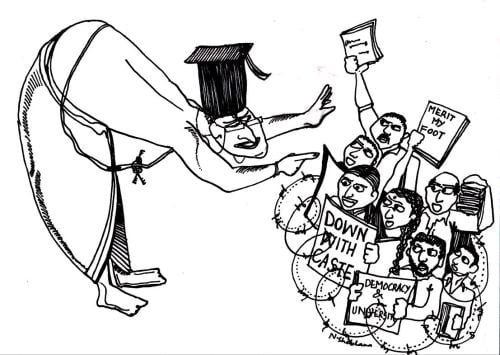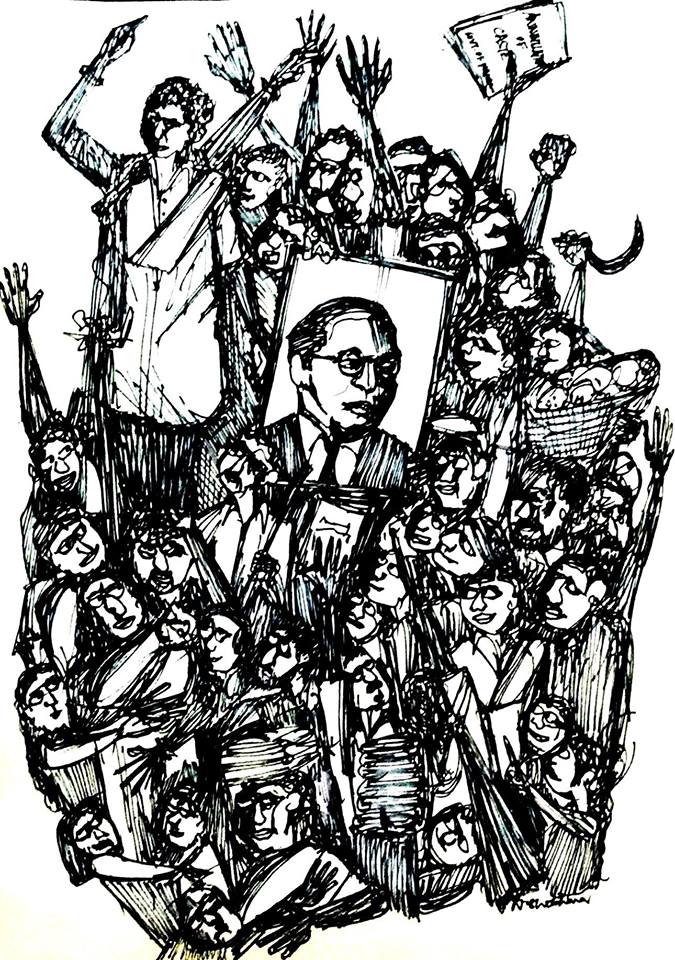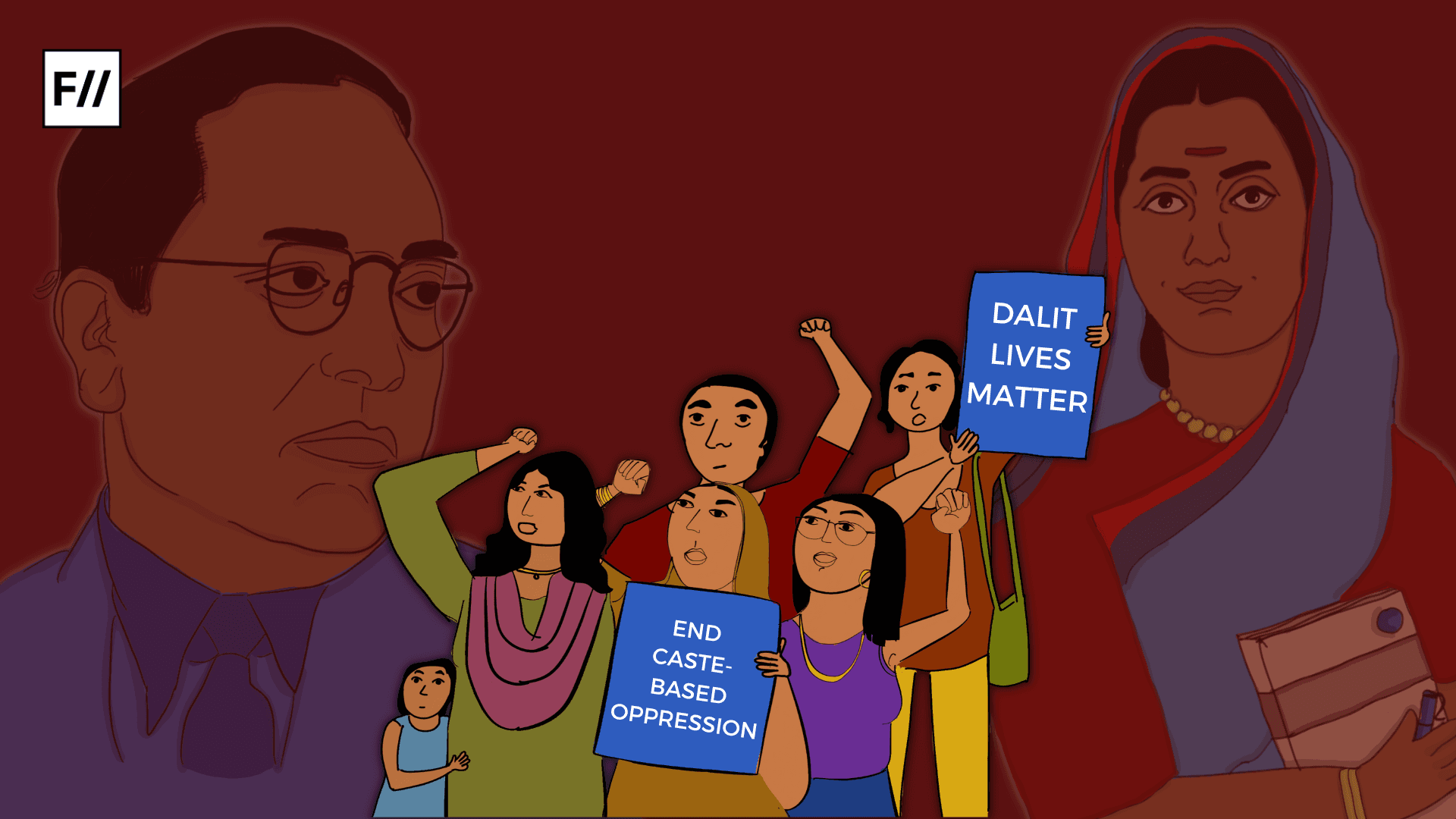The contemporary anti-caste movement has seen a moral reckoning among the Brahmanical class to be allies in the movement. While there is some intellectual honesty in the blatant casteism of the right wing, the Savarna progressives find gullible ways to exhibit their caste affiliations. Hence, such liberals are under critical scrutiny for their role and position to annihilate caste in the movement. A great amount of self-criticism is required to shred caste privileges and to save oneself from deviating into their casteist behavior. Unsurprisingly, the secular Brahmin has time and again exposed their Brahmanical propensities and strategic caste narcissism at appropriate political situations.
The Savarnas have reaffirmed similar dispositions in the recent Twitter call-out against the progressives, wherein they were severely condemned for the casteist and sexist behaviour against the former Uttar Pradesh Chief Minister and Bahujan leader Mayawati and the cheap mockery of the reservation policies enforced for the marginalised communities in India. Since they have not failed to disappoint the Bahujan community with their substandard lip service, here are some ways through which the Savarnas can renovate their ‘Dalit Saviourship Project’ and save it from an apocalyptic collapse. The aim is to understand the intricacies of the anti-caste discourse before hastening to extricate the Bahujans from their own oppression
1. Do not dismiss caste as a mere material reality
The caste factor is only deemed as detrimental when it is pertaining to reservations and atrocities inflicted explicitly through caste based prejudices. There is an inherent tendency among the Savarnas to invisibilise the prevalence of caste in the structural normative. While most of the elite Savarnas reduce assertion and the constructional penetration of caste in Ambedkarite narratives as a gimmick of ‘identity politics’, it is obvious that this gaze can only be re-fixed when the privileges of their Savarna identity are brought to the forefront.
The Savarnas, in their attempt to ‘understand’ caste experiences and livelihood end up dehumanizing the Bahujan community. This explorer’s outlook to study the ‘exotic’ for satisfying their intellectual curiosity is a way of combining romance with oppression
Upper-caste prerogatives often make it difficult for Savarnas to discern and realise the inevitability of caste in academic, recreational, professional and media spaces. The Savarna caste fraternity and hegemony continue to dominate social and political institutions. Further, it is also important to understand that gender based violations on Bahujan queers and women cannot be seen in a vacuum and in isolation of their caste identities. Any attempt to disregard the interplay of caste only trivializes their oppression and is a gate pass from any accountability for the Savarnas.
Also read: Casteism In Places Of Equality: Dalit Bahujan Women’s Experiences In The Development Sector
2. Do not fetishise caste
The Savarnas, in their attempt to ‘understand’ caste experiences and livelihood end up dehumanizing the Bahujan community. This explorer’s outlook to study the ‘exotic’ for satisfying their intellectual curiosity is a way of combining romance with oppression. Such an exploration is often undertaken by the liberals who attempt to ridicule lived experiences in the pursuit of capitalizing on the trans-generational trauma. From scoring Instagram followers by twerking to reels on caste atrocities and deaths, ensnaring Bahujan people for refurbishing their mediocre faculties on the anti-caste discourse and tokenizing inclusivity for social currency to glorifying caste based labour and occupations, progressive Savarnas leave no stone unturned to elevate their supposedly moral positions.
With no sensitivity or acknowledgement of caste capital and willingness to unlearn, they unapologetically feel entitled to conversations and dialogues that will help maintain their intellectual supremacy. While it is understood that conversations are indispensable for effective changes, it is important to realize tat they should come from a place of empathy and cognizance of one’s privileged social position.

3. Do not homogenise and commodify caste identities
The Savarna discourse reduces caste discussions to ‘Dalit trauma’ which is damaging to the heterogeneous and diverse caste identities of the Pasmanda, Vimuktas, Semi-Nomadic Tribes, Nomadic Tribes and Other Backward Castes included in the graded caste hierarchy. The competent ignorance to look beyond the binary of Dalit and Savarna; and address the nuances of caste identities, their aspirations and oppression is reflective of the patronising politics adopted by the Savarnas. The convenience to focus on ‘Dalit‘ and strip the humanity from that term without having to land a single blow to the system that facilitates Brahmanical supremacy, severely damages the anti-caste movement.
While social media allyship is a comfortable getaway to posture as anti-caste allies, the transformative nature of solidarity demands one to address the deep seated casteism in their immediate fraternal environment. As Dr. Suraj Yengde rightly puts it that ‘a Brahmin must be a cultural suicide bomber’
Further, the ‘thingification’ of Dalit identity as a political and cultural category to be studied, critiqued, used and discarded in isolation is an attempt to uniquely commodify Dalits as a distinct and separate whole and in the process render their identity impervious to the consequences of Brahmanical hierarchy. The continued usurpation of the term ‘Dalit’ by the oppressors legitimizes the disparities in the living conditions instead of truly questioning them. The social nature of caste construction is naturalised through the sympathetic narratives of ‘Dalithood’ given by the oppressor castes. Traditionally, by shifting the gaze to the victim from the perpetrator, the Savarnas immune themselves from introspecting on the accountability of their own exploitative structure.
4. Don’t make your allyship convenient
While social media allyship is a comfortable getaway to posture as anti-caste allies, the transformative nature of solidarity demands one to address the deep seated casteism in their immediate fraternal environment. As Dr. Suraj Yengde rightly puts it that ‘a Brahmin must be a cultural suicide bomber’,demanding the Savarnas to enter the upper caste corridors of power to which only they have access, and detonate the congenital castiesm of the Brahmanical culture.
The responsibility of the anti-caste work must fall on those who have access to the networks of power that maintain the monopoly on the access to resources and especially those who position themselves as anti-caste bandwagons. While Bahujans are termed as reactive, radical and ‘militant’ for their condemnation and call-outs against Brahmanical casteism, it can be ascertained that the flimsy Savarna consciousness can be evoked through petite dialogues among their own caste community. This certainly saves the labor and emotional reserves of the Bahujans depleted in the daunting process. Thus, rather than focusing on liberating the Bahujans, Savarnas can try liberating their alike from the brutality of their own oppressive system and ancestral history.
Further, since most of the Savarnas who sell the allyship bait are seen in recognized positions of power, it is fundamental that they incorporate structural reformation and inclusive policies in their own private networks. This comes with diverse representation in both the managerial and operational positions of work. However, such inclusivity should not be limited to professional spaces, but also extended to universities that inhabit students from diverse locations and communities. The upper-caste and upper class aesthetic culture of the Savarna students, distinguishable in educational spaces simply exposes their disregard towards material realities. Often this hegemonic culture perpetuates exclusivity and isolation for the students from the Bahujan community.

5. Do not appropriate Bahujan spaces and voices
The Bahujan community is long done with the Savarna’s “wanting to give back” attitude. From media forums to protests, the Savarnas have not failed to hijack the anti-caste movement through their performative allyship. The benevolent casteism of the progressives should be put to immediate rest. The ‘passing the mic‘ politics should make the oppressor caste realise that the mic that they primarily hold is stolen, and not theirs. Most of the liberals in academic and media spaces will talk about ‘passing the mic‘ and assume silence when done. This is nothing but Savarna solidarity 101.
Infact, the liberals have an adept experience to manipulate any trending anti-caste political current in their favor. Since the Hathras rape case, there is a rampant rise of the ‘passing the mic‘ epistemology. Several independent media personalities like Faye D’souza were seen hosting Dalit speakers and scholars on their channels, only to ghost us later with their myopic view of saviour-ship. The steep dehumanising tokenism is revealed at the visual of a Bahujan person fighting to be an equal.
Also read: Why Do We Need More Dalit Women & Dalit Queer Writers In India Today?
Rather, they would embrace one who has tweaked and mutated into a convenient caricature of what they define as a Dalit person. If you are ready to do the victim role play, they will certainly applaud and celebrate your victimhood. The Savarna narrative conforms that by ‘passing the mic‘, Bahujans are not supposed to dismantle the stage but rather take the opportunity to perform on the stage. On performing you are expected to entertain them with Bahujan experiences, diversity and inclusion.

On the contrary, the Bahujan movement desires to claim agency on identity assertion-which is both the reiteration of what a Bahujan identity is and the rejection of what it is not. The anti-caste movement can only be emancipatory without the conservative indulgence of the Savarnas in the revolutionary discourse. The Dalit identity is an imposed identity. One is not born as a Dalit, but seen as a Dalit by the Brahmanical society. Thus, true solidarity demands one to re-fix the condescending gaze and work towards deconstructing the very caste system that facilitates Brahmanical supremacy.
References:
- For the perfect progressive recipe, skip caste, sprinkle Dalit Swadanusar: Gaurav Somwanshi
- Dalit: Identity or Commodity for Savarnas?
This is by no means an exhaustive or representative list. Suggestions to add to this list are welcome in the comments section.
Featured Image Source: Syam Cartoonist at Round Table India
About the author(s)
Mansi Bhalerao is an Ambedkarite feminist, an undergraduate at Miranda House. She is an aspiring student of Sociology, trying to navigate and assert her praxis.





Ashraf is not sanctioned by holy Qur’an and sunnah.none of the so-called Ashraf caste are sayyid.the only sayyid are Muhammed kins in hejaz.also it was Delhi sultanate,and Mughals created it.despite this shariatullah,and Syed noumani opposed caste system in muslim society.so before using caste system which is unholy with your holy caste system.think about twice.constitution already banned caste system,just forget it.